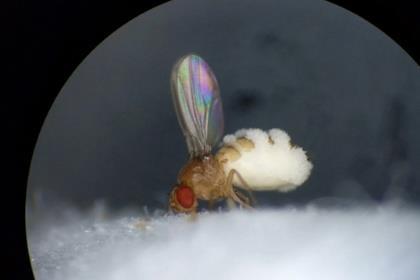Scientists have uncovered the molecular and cellular underpinnings behind the ability of the parasitic fungus Entomophthora muscae’s ability to manipulate the behaviour of fruit flies.

The study led by Carolyn Elya, postdoctoral researcher in the Department of Organismic and Evolutionary Biology at Harvard, is published in eLife.
Elya first described the manipulated behaviour, called summiting, in a study published in eLife in 2018. Elya, who was studying microbes carried by fruit flies while a graduate student at University of California (UC) Berkeley, set out rotting fruit to capture wild fruit flies. When she later checked to see is she had captured any, she found instead zombie flies, with a banding pattern on their abdomen, that had died striking an interesting pose. Through extraction and sequencing of DNA Elya confirmed the suspected cause, E. muscae.
Sunset hours
Summiting occurs at sunset when the infected flies climb to an elevated location and extend their proboscises to the surface. A sticky droplet that emerges from the proboscis adheres the fly to the surface right before the wings raise up and away from the body and the flies die.
“The climbing is very important as it positions the fly in an advantageous location for the fungus to spread to the most possible hosts,” says Elya. “The fungus jumps to the new host by forming very specialized and temporary structures that burst through the fly’s skin and shoots spores into the environment that are only good for a handful of hours. It’s a fleeting process, so an advantageous position is everything to survival.”
While at UC Berkeley, Elya developed a laboratory model she refers to as the Entomophthora muscae-Drosophila melanogaster ‘zombie fly’ system using the wild fungal isolate she found in her backyard. With this system, Elya could continuously infect fruit flies – a laboratory staple, as well as culture the fungus independently of the fly host in media thought to mimic the internal environment of the fly.
Last hours of life
Summiting has appeared several times in scientific literature, but studies had only been observations of dead house flies. No one had ever observed how flies behave in their last hours of life.
Elya set out to fill this knowledge gap of what happens when flies summit by developing a high-throughput behavioural assay to automatically track hundreds of infected flies. While using this platform to monitor the behaviour of flies becoming zombies, she encountered a surprise. “We found that summiting is not about climbing,” said Elya. “It’s actually this burst of locomotor activity that starts about two and a half hours before the flies die.”
With this discovery, Elya and co-authors paired her system to create on-demand zombie flies with the lab’s powerful fruit fly genetic toolkit. With these and the author’s new behaviour assay they could identify genes and neurons required for flies to summit.
“Overall, we found the flies hormonal axes was mediating summiting behaviour. When we silenced these neurons the flies were really bad at summiting,” Elya says. These neurons send projections to a neurohemal organ that produces juvenile hormone, a hormone conserved in insects.
“We think the fungus is actually driving the activity of these neurons in order to drive the release of this hormone, which is causing the flies to have this burst of locomotor activity.”
Occupying the brain
Elya and co-authors were then able to collect a behavioural dataset consisting of hundreds of infected flies, which they then used to train a computer to identify flies as they are summiting. This classifier tool enabled the team to discover that fungal cells invade the fly’s brains in an organized way, occupying specific regions of the brain during summiting.
Interestingly, the team also discovered that the flies blood brain barrier is compromised when exposed to the fungus. Normally the neurons are protected from the blood that’s circulating through the fly’s body. The breakdown of the blood brain barrier has important consequences for what the neurons are being exposed to, potentially allowing things that are circulating in the blood to interact with neurons in the brain, thus providing a route for modulating neural activity.
“We think this could be important for the way that the fungus is driving behavioural changes, and we actually found that you can pull blood from flies that are doing the summiting behaviour, put it into naive flies and drive some of this increased locomotion,” Elya said.
”So we’ve shown that there’s at least the partial ability to recapitulate this summiting behaviour just by transferring fly blood.”
Elya says that these experiments show some blood-borne factors can drive summiting behaviour, though it’s not yet clear what the identity of these factors are or who produces them (the fungus or the fly).
Elya hopes to next develop transgenics to help modulate things from the fungus side in addition to perturbations that can already be made in the flies. “There are still a lot of open questions here. What the fungus is doing is still a mystery.”




No comments yet